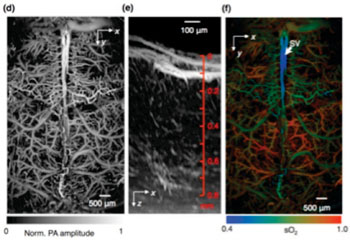Photoacoustic Microscopy Enables Rapid Imaging of the Brain's Oxygen Metabolism
By LabMedica International staff writers
Posted on 13 Apr 2015
Photoacoustic microscopy (PAM) is a novel imaging technique that was exploited by researchers to view the vascular morphology, blood oxygenation, blood flow, and oxygen metabolism in both resting and stimulated states in the mouse brain.Posted on 13 Apr 2015
In PAM, non-ionizing laser pulses are delivered into biological tissues. Some of the delivered energy is absorbed and converted into heat, leading to transient thermoelastic expansion and wideband ultrasonic emission. The generated ultrasonic waves are detected by ultrasonic transducers and then analyzed to produce images. Optical absorption is closely associated with physiological properties, such as hemoglobin concentration and oxygen saturation. As a result, the magnitude of the ultrasonic emission (photoacoustic signal), which is proportional to the local energy deposition, reveals physiologically specific optical absorption contrast. Two-dimensional or three-dimensional images of the targeted areas can then be formed.

Image: Fast functional photoacoustic microscopy of the mouse brain. Figure (d) shows a representative x-y projected brain vasculature image through an intact skull. Figure (e) shows a representative enhanced x-z projected brain vasculature image. Figure (f) shows photoacoustic microscopy of oxygen saturation of hemoglobin in the mouse brain, acquired by using the single-wavelength pulse-width-based method with two lasers (Photo courtesy of Washington University).
Investigators at Washington University (St. Louis, MO, USA) recently described using a single-wavelength pulse-width-based PAM method with a one-dimensional imaging rate of 100 kHz to image blood oxygenation with capillary-level resolution in the mouse brain.
They reported in the March 30, 2015, online edition of the journal Nature Methods that this technology enabled them to take images of blood oxygenation 50 times faster than in previous studies using fast-scanning PAM; 100 times faster than an acoustic-resolution system; and more than 500 times faster than phosphorescence-lifetime-based two-photon microscopy (TPM).
“Using this new single-wavelength, pulse-width-based method, PAM is capable of high-speed imaging of the oxygen saturation of hemoglobin,” said senior author Dr. Lihong Wang, professor of biomedical engineering at Washington University. “In addition, we were able to map the mouse brain oxygenation vessel by vessel using this method. PAM is exquisitely sensitive to hemoglobin in the blood and to its color change due to oxygen binding. Without injecting any exogenous contrast agent, PAM allows us to quantify vessel by vessel all of the vital parameters about hemoglobin and to even compute the metabolic rate of oxygen. Given the importance of oxygen metabolism in basic biology and diseases such as diabetes and cancer, PAM is expected to find broad applications.”
Related Links:
Washington University













